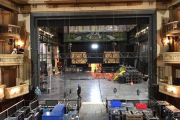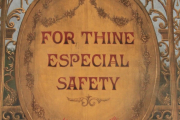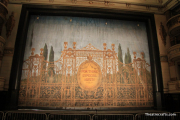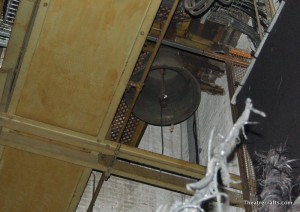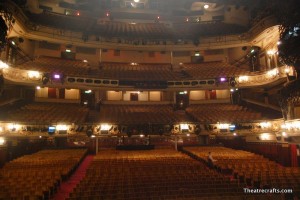Dates: 1812 – present
Official website: https://lwtheatres.co.uk/theatres/theatre-royal-drury-lane
The largest stage in the West End, and a superbly rich theatrical legacy makes this venue a very special place to visit. During the run of a show, check out the Drury Lane Tours which are packed with backstage exploration and tell some of the incredible stories associated with the space. (The tours are not available during fit-ups or technical rehearsals).
Past Productions & History
Source for some of the below: http://www.reallyuseful.com/theatres/theatre-royal-drury-lane/history/
- Hercules (opening June 2025)
- The Tempest (7 December 2024 – 1 February 2025) The Jamie Lloyd Company, starring Sigourney Weaver
- Much Ado About Nothing (10 February 2025 – 5 April 2025) The Jamie Lloyd Company, starring Tom Hiddleston, Hayley Atwell
- Frozen (From 27 August 2021 (delayed due to Coronavirus – was originally due to start previews in April 2021), closing 8 September 2024)
- 2019 January: Theatre closed for redevelopment, including the removal of the historic understage machinery
Planning Documents (2017-2018) relating to the redevelopment
The redevelopment will consist of:
– removal of the historic understage lifts and machinery to create a clear substage area for technically-complex shows
– creation of new FOH routes into the auditorium, so that all audience-members will use the grand entrance
– rebuilding of the balconies in the auditorium so that they embrace the stage more, and are more curved at the ends. This will entail the removal of some of the boxes. - 42nd Street (Previews from 20 March 2017. Closed 5th January 2019)
- Charlie and the Chocolate Factory (May 2013 to January 2017) 1543 performances
- Shrek (May 6 2011 – February 2013)
- Oliver! (December 2008 – January 2011) 828 performances.
- The Lord of the Rings (June 19, 2007 – July 19, 2008)
- Since December 2005 the Theatre Royal, Drury Lane, has been owned 100% by the Really Useful Group Limited.
- The Producers (Previews 29 October 2004, opened 9 November 2004, closed 6 January 2007) 920 performances.
- Anything Goes (7 October 2003 – 2004?) Trevor Nunn’s National Theatre production
- The Stars of the Bolshoi (2001)
- The League of Gentlemen (2001)
- My Fair Lady (2001 – 2003) Cameron Mackintosh’s revival, from the National Theatre, starring Jonathan Pryce. 878 performances.
- The Witches of Eastwick (26 May 2000 – 24 February 2001) transferred to Prince of Wales Theatre
- Royal Command Performance (1991)
- Miss Saigon (Previews September 4 1989, Opened September 20 1989, Closed 1999) A total of 4264 performances.
- Back with a Vengence, The Second Coming (March 9 1989 – 29th April 1989) starring Barry Humphries (aka Dame Edna Everage / Sir Les Patterson)
- Royal Command Performance (1986)
- Royal Command Performance (Recorded 25 November 1985 & broadcast December 1985) [This was the final time the stage bridges were used]
- 42nd Street (8 August 1984 – 7 January 1989) 1824 performances
- Dancin’ (Previews 11 November 1983, Opens 14 November 1983, closed 28 January 1984) directed by Bob Fosse, Lighting by Jules Fisher. Limited run.
- Royal Variety Performance (1982)
- The Pirates of Penzance [Broadway version] (26 May 1982 – 29 October 1983)
- Barry Humphries – An Evenings Intercourse (4th February -10th April 1982)
- The Secret Policeman’s Other Ball (9-12 September 1981) benefit for Amnesty International
- Royal Variety Performance (1981)
- The Best Little Whorehouse in Texas (1981 – 1982?)
- Sweeney Todd (1980) starring Dennis Quilley and Shiela Hancock
- Royal Variety Performance (1979)
- A Chorus Line (1976 – 1979) 1113 performances
- Billy (1974 – 1976) starring Michael Crawford, followed by Roy Castle. 904 performances.
- No, No Nanette (16 May 1973 – ?)
- Gone with the Wind (May 3 1972 – April 7 1973 (398 performances)) Musical version, produced by Harold Fielding
- The Great Waltz (9 July 1970 – 1972) produced by Harold Fielding – 605 performances
- Carol Channing (22 April 1970 – 20 June 1970) “A New Style Revue” staged by Joe Layton
- Mame (Previews from 10 February 1969; Opened 20 February 1969; Closed 14 March 1970) starring Ginger Rogers. Cost £100,000, weekly operational bill of £15,000
- The Four Musketeers (5 December 1967 – 18 January 1969) starring Harry Secombe
- Hello, Dolly! (1965 – 1967) starring Mary Martin (to 1966) then Dora Bryan (1966-67)
- Camelot (1964 – 1965) starring Paul Daneman, Elizabeth Larner
- Antonio (1964)
- The Boys from Syracuse (1963) revival starring Bob Monkhouse & Ronnie Corbett
- My Fair Lady (1958 – 1963) starring Julie Andrews, Rex Harrison & Stanley Holloway in Cecil Beaton’s costumes. A total of 2281 performances.
- The Tempest (1957) Shakespeare Memorial Theatre company, featuring John Gielgud, Robert Harris, Richard Johnson
- Fanny (1956) starring Robert Morley
- The King and I (1953 – 1956) starring Valerie Hobson and Herbert Lom. 947 performances
- South Pacific (1 November 1951 – 1953) starring Mary Martin
- Carousel (1950 – 1951)
- Oklahoma! (1947 – 1950) originally starring Howard Keel. 1527 performances.
- Pacific 1860 (1946) Coward’s post-war musical starred Mary Martin but did not tap into the public psyche as well as Cavalcade (1931) and closed after four months.
- War Years – During the Second World War the theatre was the home base for ENSA and received a direct hit from a gas bomb which, fortunately, did not explode but did destroy the rear of the auditorium.
- The Dancing Years (1939) Ivor Novello
- Crest of The Wave (1 September 1937, for 203 performances) starring Ivor Novello, Dorothy Dickson, Olive Gilbert, Walter Crisham and Edgar Elmes. Directed by Leontine Sagan. Features on-stage train crash.
- Careless Rapture (1936) Ivor Novello. Features on-stage earthquake.
- Glamorous Night (1935) Ivor Novello – featured a full-scale shipwreck (1935-1939 Novello starred in all of the productions and in true Drury Lane fashion introduced as many major scenic effects as possible, including sinking ships, a fair on Hampstead Heath, a train crash and an earthquake.)
- Three Sisters (1934)
- Cavalcade (from 31 October 1931, for 405 performances) Noel Coward (Produced by C.B. Cochrane, the cast of 400 included a young John Mills and set-pieces including the sinking of the Titanic, a troopship setting sail, the relief of Mafeking and Queen Victoria’s funeral.)
The 2 downstage electric stage lifts were purchased and installed for Cavalcade, to work alongside the two hydraulic tilting and 2 more upstage electric lifts. - The Song of the Drum (January 9 1931 – ?)
- The New Moon (1929) starring Evelyn Laye (who received ‘torrents of applause’) and featuring a blazing pirate ship as one of the scenic attractions.
- Show Boat (1928 – 1929) – original London production starring Paul Robeson, Edith Day, Cedric Hardwicke and Alberta Hunter.
- The Desert Song (1927-1928) – original London production, starring Edith Day. Anna Neagle made her debut in this show.
- Rose Marie (1924 – 1927) – original London production, starring Edith Day. 851 performances. (?1925 start)
- Decameron Nights (1922)
- Cinderella (1919)
- The Whip (1909 – 1910)
- The Marriages of Mayfair (Autumn 1908) The stage and roof were swiftly rebuilt and the theatre opened in the Autumn of 1908.
- March 25 1908 A fire destroyed the stage and backstage areas. The auditorium and front of house was saved by the safety curtain and a fast response from firemen.
- Ben-Hur (April 3 1902 – ?)
- Best of Friends (1902)
- The Great Ruby (1898)
- First used gas lighting in both the stage and auditorium on 6th September 1817 – the first theatre to use gas throughout the building. The Lyceum first used gas on stage only on 6th August 1817.
- Hamlet, Prince of Denmark (1812)
- 1812 – The fourth and present building opened in 1812. It was designed by Benjamin Wyatt and the front of house areas today are much as they were at the first performance. The building was financed by a ‘Committee of Renters’ recruited by the brewer Samuel Whitbread, and Lord Byron was Chairman of the board. It was here that Edmund Kean became a star overnight with his performance of Shylock, where the great clown Joseph Grimaldi gave his farewell benefit performance and where Dan Leno and Herbert Campbell triumphed in a series of spectacular pantomimes. Drury Lane became famous throughout the rest of the 19th and early 20th centuries for producing spectacles under the guidance of its adventurous managers, most notably F.B. Chatterton, Augustus Harris, Arthur Collins and Alfred Butt. Scenes staged included chariot races in Ben Hur, the Derby and an earthquake in The Hope, the Battle of Rorke’s Drift in Youth, a train crash in The Whip, sinking ships, air balloons, underwater fights, the Chelsea Flower Show, Madame Tussaud’s Chamber of Horrors, the flooding of Paris and Alpine avalanches.
- 1809? – Despite having the world’s first safety curtain, the theatre burned down only 15 years later, bringing Sheridan’s management, and personal fortune, to the ground along with it.
- 1794 – Sheridan oversaw the demolition of the ageing building and its replacement by a larger theatre to seat 3,600 people, designed by Henry Holland. It opened in March 1794 with a performance of sacred music by Handel because theatrical performances were banned during Lent.
- The School for Scandal (1777) Premiere performance of Sheridan’s play
- 1776 – Richard Brinsley Sheridan took over running the theatre.
- 1747 – David Garrick became the manager of the theatre, and introduced many reforms which have shaped modern theatre.
- 1674 – Thomas Killigrew rebuilt the theatre, which opened in 1674 and remained in operation for 117 years. This building witnessed the triumphs of Thomas Betterton who played Hamlet when he was over 70, Charles Macklin who murdered a fellow actor in the Green Room and lived to be over 100, Peg Woffington, Mrs Jordan, Sarah Siddons and Charles Kemble.
- 1672 – The theatre was destroyed by fire.
- 1665 – Nell Gwynne made her debut on the stage, and was first seen there by King Charles II. Samuel Pepys also visited the theatre.
- 1663 – The first Theatre Royal at Drury Lane is erected by Thomas Killigrew, on request from King Charles II. The theatre building was around the size of the current stage.
Equipment
1912 (from The Stage Guide)
Depth of stage; about 100 ft. Width from wall to wall, about 100ft. proscenium, 50ft to 50ft (about). Electric light, 100 volts continuous current. 25 dressing rooms.
1946 (from The Stage Guide)
Revolving stage. Six lifts.
Electrical equipment: 100V D.C. Footlights, four circuits with ind. dimmers. 10 battens each with three circuits with ind. dimmers. Cyclorama top lighting with 36 floods coupled to 36 dimmers. Cyclorama lighting with three circuits ind. dimmed. All dips with ind. dimmers, all dips switch controlled. 26 f-o-h pre-set spots with ind. dimmers. Five f-o-h following limes.
Dressing rooms: 28. Orchestra, acc. 50. Amoplifying equipment: Two-turntable reproducer. F-o-h or stage Microphone. Footlights are removable.
1971 (from The Stage Guide)
Electrics: Strand Light Console SL. Dimmers – 216 (1500W +/- 1/3); presets – 24 + 10 memories. Circuits – FOH 26; Flies 158; Stage dips 32. Socket type – 15A BESA (Strand 25A in stage dips). Total capacity available – 400A on each of 3 phases. Special effects supply – 100A on 3 phases. Follow spots – 4 x 100A arcs in back of Gallery. Footlights can be covered.
Stage Lighting Control
The stage lighting control systems (Grand Master and Light Console) were operated from the stage left wing.
The Grand Master was located on a small platform above the stage left wing, part of which remains to this day.
The Light Console was in a small room between the proscenium and the auditorium, which afforded a view of the stage through a window with a metal shutter. This can be seen in the photo of Ernest Trim below, and in the photos taken in January 2019. The room was more recently used as a base for the on-stage radio mic technician during large shows.

SL Wing wall (January 2019)
Click on thumbnail to enlarge
[290kb JPEG]
From Backstage Heritage Collection
![[05] Light Console - Theatre Royal Drury Lane - Ernest Trim at Console](/archive/docthumbs/169.jpg)
[05] Light Console - Theatre Royal Drury Lane - Ernest Trim at Console
Click on thumbnail to enlarge
[529kb JPEG]
From Frederick Brown Collection

Light Console room at the Theatre Royal Drury Lane (January 2019)
Click on thumbnail to enlarge
[275kb JPEG]
From Backstage Heritage Collection

Light Console room at the Theatre Royal Drury Lane (January 2019)
Click on thumbnail to enlarge
[191kb JPEG]

Light Console room with shutter opened (but blocked off on auditorium side) (January 2019)
Click on thumbnail to enlarge
[199kb JPEG]
Exhibits from this venue in the Backstage Heritage Collection
Links to information about equipment at Theatre Royal Drury Lane over the years
Documents

Drury Lane Light Console Proposal - Fred Bentham (November 1943)
[302kb PDF]
From David Bertenshaw Collection

Letter to Fred Bentham - Drury Lane Console (October 1948)
[80kb PDF]
From David Bertenshaw Collection

My Fair Lady - Joe Davis (August 1957)
[LX Plan - click on the thumbnail]
From David W. Kidd Collection

The Great Waltz - Michael Northen (July 1970)
[LX Plan - click on the thumbnail]
From David W. Kidd Collection

Gone with the Wind - Richard Pilbrow (March 1972)
[LX Plan - click on the thumbnail]
From David W. Kidd Collection

No No Nanette - Joe Davis (April 1973)
[LX Plan - click on the thumbnail]
From David W. Kidd Collection

Hello Dolly (Original Plan) - Joe Davis (August 1979)
[LX Plan - click on the thumbnail]
From David W. Kidd Collection

Hello Dolly (Working Plan) - Joe Davis (August 1979)
[LX Plan - click on the thumbnail]
From David W. Kidd Collection

Sweeney Todd - Ken Billington (June 1980)
[LX Plan - click on the thumbnail]
From David W. Kidd Collection

Sweeney Todd - Ken Billington (July 1980)
[LX Plan - click on the thumbnail]
From David W. Kidd Collection

The Pirates of Penzance - Jennifer Tipton (April 1982)
[LX Plan - click on the thumbnail]
From David W. Kidd Collection

Dancin - Jules Fisher (December 1983)
[LX Plan - click on the thumbnail]
From David W. Kidd Collection

Back with a Vengeance - Durham Marenghi (March 1989)
[LX Plan - click on the thumbnail]
From David W. Kidd Collection

Miss Saigon - David Hersey (May 1991)
[LX Plan - click on the thumbnail]
From David W. Kidd Collection

LSI: Classic Gear - Stage Lifts (February 2019)
[External Website]
From Lighting & Sound International

Classic Gear - London Hydraulic Power Company (July 2021)
[External Website]
From Lighting & Sound International

